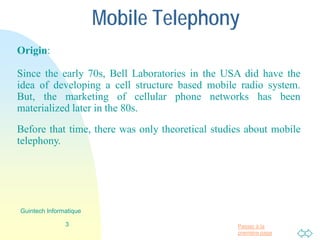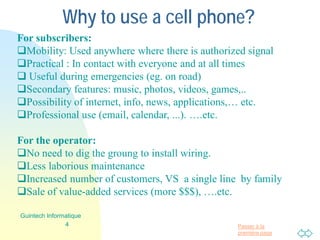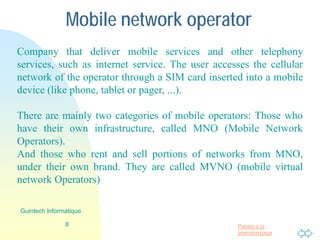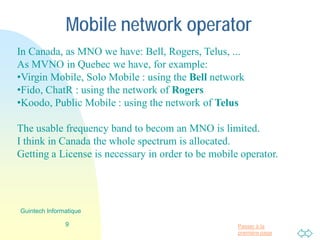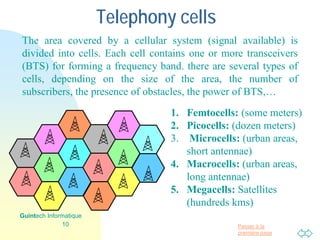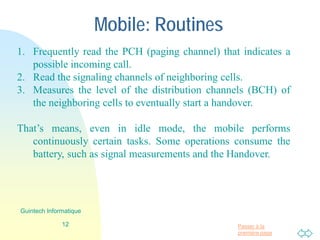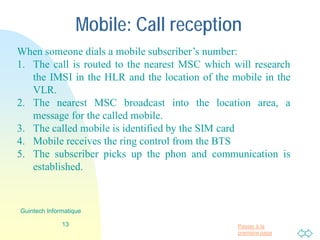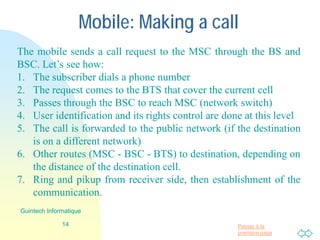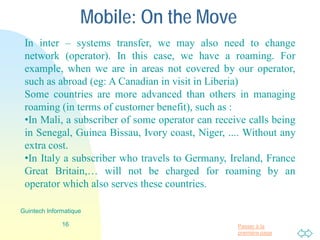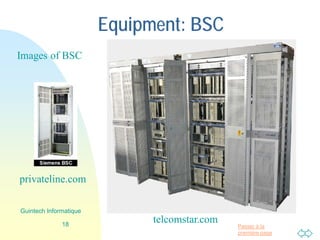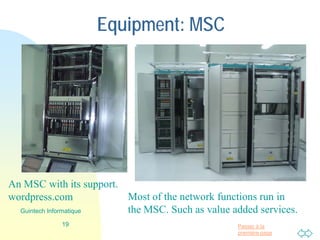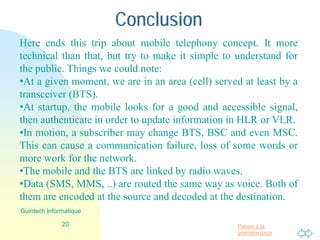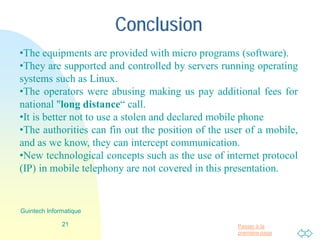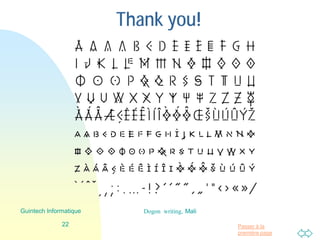Introducing mobile telephony
- 1. Passer ├Ā la premi├©re page Introduction to mobile telephony Some cellular telephony concepts 1 Guintech Informatique Tana Guindeba Jr Engineer May 2014
- 2. Passer ├Ā la premi├©re page Mobile Telephony Definition: GSM: Global System for Mobile Communication, is a standard developed in the 80s in order to define the parameters for a digital cellular communication network. The GSM standard is universally used for wireless communication networks. In Canada, United States and in Japan, there is also the CDMA (Code division multiple access) standard . 2 Guintech Informatique
- 3. Passer ├Ā la premi├©re page Mobile Telephony Origin: Since the early 70s, Bell Laboratories in the USA did have the idea of developing a cell structure based mobile radio system. But, the marketing of cellular phone networks has been materialized later in the 80s. Before that time, there was only theoretical studies about mobile telephony. 3 Guintech Informatique
- 4. Passer ├Ā la premi├©re page Why to use a cell phone? For subscribers: ’ü▒Mobility: Used anywhere where there is authorized signal ’ü▒Practical : In contact with everyone and at all times ’ü▒ Useful during emergencies (eg. on road) ’ü▒Secondary features: music, photos, videos, games,.. ’ü▒Possibility of internet, info, news, applications,ŌĆ” etc. ’ü▒Professional use (email, calendar, ...). ŌĆ”.etc. For the operator: ’ü▒No need to dig the groung to install wiring. ’ü▒Less laborious maintenance ’ü▒Increased number of customers, VS a single line by family ’ü▒Sale of value-added services (more $$$), ŌĆ”.etc. 4 Guintech Informatique
- 5. Passer ├Ā la premi├©re page Some terminologies SIM: Subscriber Identity Module, contains information on the Subscriber, also datas and applications. MS: mobile station, Equipment used by the subscriber to access the services offered by the operator (mobile + SIM). IMEI: International Mobile Equipment Identity, single code identifying the mobile, verified at every utilization. Also detect lost or stolen phon. Can be obtained by digiting *#06# IMSI: International Mobile Subscriber Identity, unique number identifying a GSM subscriber. (usually 15 digits, associated with mobile phone users) BTS: Base Transceiver Station, communicate with mobiles, form the cells (we can see them on the towers, mountains,ŌĆ”) 5 Guintech Informatique
- 6. Passer ├Ā la premi├©re page Some terminologies BSC: Base Station Controller, connects several BTS, manages handoff between BTS. MSC: Mobile Switching Center, control center, actions coordination, many functions run here. EIR: Equipment Identity Register, identity of mobile device ( list of authorized IMEI) HLR: Home Location Register, information about subscribers (position, status, services,..). VLR: Visitor Location Register, concern a region, current area. HLR and VLR communicate for update. AUC: Authentication Centre, manage security policies, calls and network protection 6 Guintech Informatique
- 7. Passer ├Ā la premi├©re page GSM network architecture 7 Guintech Informatique Here is what a basic mobile network looks like. The GMSC routes calls coming from or going outside of the network Image Source : www.efort.com
- 8. Passer ├Ā la premi├©re page Mobile network operator Company that delivers mobile services and other telephony services, such as internet service. The user accesses the cellular network of the operator through a SIM card inserted into a mobile device (like phone, tablet or pager, ...). There are mainly two categories of mobile operators: Those who have their own infrastructure, called MNO (Mobile Network Operators). And those who rent and sell portions of networks from MNO, under their own brand. They are called MVNO (mobile virtual network Operators) 8 Guintech Informatique
- 9. Passer ├Ā la premi├©re page Mobile network operator In Canada, as MNO we have: Bell, Rogers, Telus, ... As MVNO in Quebec we have, for example: ŌĆóVirgin Mobile, Solo Mobile : using the Bell network ŌĆóFido, ChatR : using the network of Rogers ŌĆóKoodo, Public Mobile : using the network of Telus The usable frequency band to becom an MNO is limited. I think that in Canada the whole spectrum is allocated. Getting a License is necessary in order to be mobile operator. 9 Guintech Informatique
- 10. Passer ├Ā la premi├©re page Telephony cells 10 Guintech Informatique The area covered by a cellular system (signal available) is divided into cells. Each cell contains one or more transceivers (BTS) for forming a frequency band. there are several types of cells, depending on the size of the area, the number of subscribers, the presence of obstacles, the power of BTS,ŌĆ” 1. Femtocells: (some meters) 2. Picocells: (dozen meters) 3. Microcells: (urban areas, short antennae) 4. Macrocells: (urban areas, long antennae) 5. Megacells: Satellites (hundreds kms)
- 11. Passer ├Ā la premi├©re page Mobile: Start up At the mobile phone startup up, the following operations are performed: 1. Validation of the SIM card through the secret code (PIN) if this feature is enabled 2. The GSM receiver scans the channels of the GSM band and measures the level of the received signal on each channel 3. The phone check the best signal. 4. Mobile retrieves information about the cell and the network. It transmits identification information to the BTS to update the location. (VLR / HLR) 5. Startup is completed, the mobile stay in idle mode and performs some routines. 11 Guintech Informatique
- 12. Passer ├Ā la premi├©re page Mobile: Routines 1. Frequently read the PCH (paging channel) that indicates a possible incoming call. 2. Read the signaling channels of neighboring cells. 3. Measures the level of the distribution channels (BCH) of the neighboring cells to eventually start a handover. ThatŌĆÖs means, even in idle mode, the mobile performs continuously certain tasks. Some operations consume the battery, such as signal measurements and the Handover. 12 Guintech Informatique
- 13. Passer ├Ā la premi├©re page Mobile: receiving Call When someone dials a mobile subscriberŌĆÖs number: 1. The call is routed to the nearest MSC which will research the IMSI in the HLR and the location of the mobile in the VLR. 2. The nearest MSC broadcast into the location area, a message for the called mobile. 3. The called mobile is identified by the SIM card 4. Mobile receives the ring control from the BTS 5. The subscriber picks up the phon and communication is established. 13 Guintech Informatique
- 14. Passer ├Ā la premi├©re page Mobile: Making call The mobile sends a call request to the MSC through the BS and BSC. LetŌĆÖs see how: 1. The subscriber dials a phone number 2. The request comes to the BTS that cover the current cell 3. Passes through the BSC to reach MSC (network switch) 4. User identification and its rights control are done at this level 5. The call is forwarded to the public network (if the destination is on a different network) 6. Other routes (MSC - BSC - BTS) to destination, depending on the distance of the destination cell. 7. Ring and pikup from receiver side, then establishment of the communication. 14 Guintech Informatique
- 15. Passer ├Ā la premi├©re page Mobile: In move When moving, it may happen that we change cell (handover). That requires reaction from the network devices, in order to maintain ongoing communication or network connection. Depending on the magnitude of the move, the BTS, the BSC or even the MSC may be involved. Note the possibility of partial or total loss of communication during a move according to the available channels and the technique used to change the BTS. Changing from one MSC to another is an inter ŌĆō systems transfer. In that case, we have the so called "long distance" that I denounced near the CRTC. 15 Guintech Informatique
- 16. Passer ├Ā la premi├©re page Mobile: In move 16 Guintech Informatique In inter ŌĆō systems transfer, we may also need to change network (operator). In this case, we have a roaming. For example, when we are in areas not covered by our operator, such as abroad (for eg: A Canadian in visit in Liberia) Some countries are more advanced than others in managing roaming (in terms of customer benefit), such as : ŌĆóIn Mali, a subscriber of some operator can receive calls being in Senegal, Guinea Bissau, Ivory coast, Niger, .... Without any extra cost. ŌĆóIn Italy a subscriber of an operator who travels to Germany, Ireland, France Great Britain, Spain,ŌĆ” will not be charged for roaming.
- 17. Passer ├Ā la premi├©re page Equipment: BTS 17 Guintech Informatique wikimedia.org gsmweb.cz Some operators pay fees to occupants of buildings that bear their BTS. itiltd-india.com
- 18. Passer ├Ā la premi├©re page Equipment: BSC 18 Guintech Informatique privateline.com telcomstar.com Images of BSC
- 19. Passer ├Ā la premi├©re page Equipment: MSC 19 Guintech Informatique Most of the network functions run in the MSC. Such as value added services. An MSC with its support. wordpress.com
- 20. Passer ├Ā la premi├©re page Conclusion 20 Guintech Informatique Here ends this trip about mobile telephony concept. It is more technical than that, but I try to make it easy to understand for the public. Things we could note: ŌĆóAt a given moment, we are in an area (cell) served at least by a transceiver (BTS). ŌĆóAt startup, the mobile looks for a good and accessible signal, then authenticate in order to update information in HLR or VLR. ŌĆóIn motion, a subscriber may change BTS, BSC and even MSC. This can cause a communication failure, loss of some words or more work for the network. ŌĆóThe mobile and the BTS are linked by radio waves. ŌĆóData (SMS, MMS, ..) are routed the same way as voice. Both of them are encoded at the source and decoded at the destination.
- 21. Passer ├Ā la premi├©re page Conclusion 21 Guintech Informatique ŌĆóThe equipments are provided with micro programs (software). ŌĆóThey are supported and controlled by servers running operating systems such as Linux. ŌĆóThe operators were abusing making us pay additional fees for national "long distanceŌĆ£ call. ŌĆóIt is better not to use a stolen and declared mobile phone ŌĆóThe authorities can fin out the position of the user of a mobile, and as we know, they can intercept communication. ŌĆóNew technological concepts such as the use of internet protocol (IP) in mobile telephony are not covered in this presentation.
- 22. Passer ├Ā la premi├©re page Thank you! 22 Guintech Informatique Writing of dogon people, Mali


